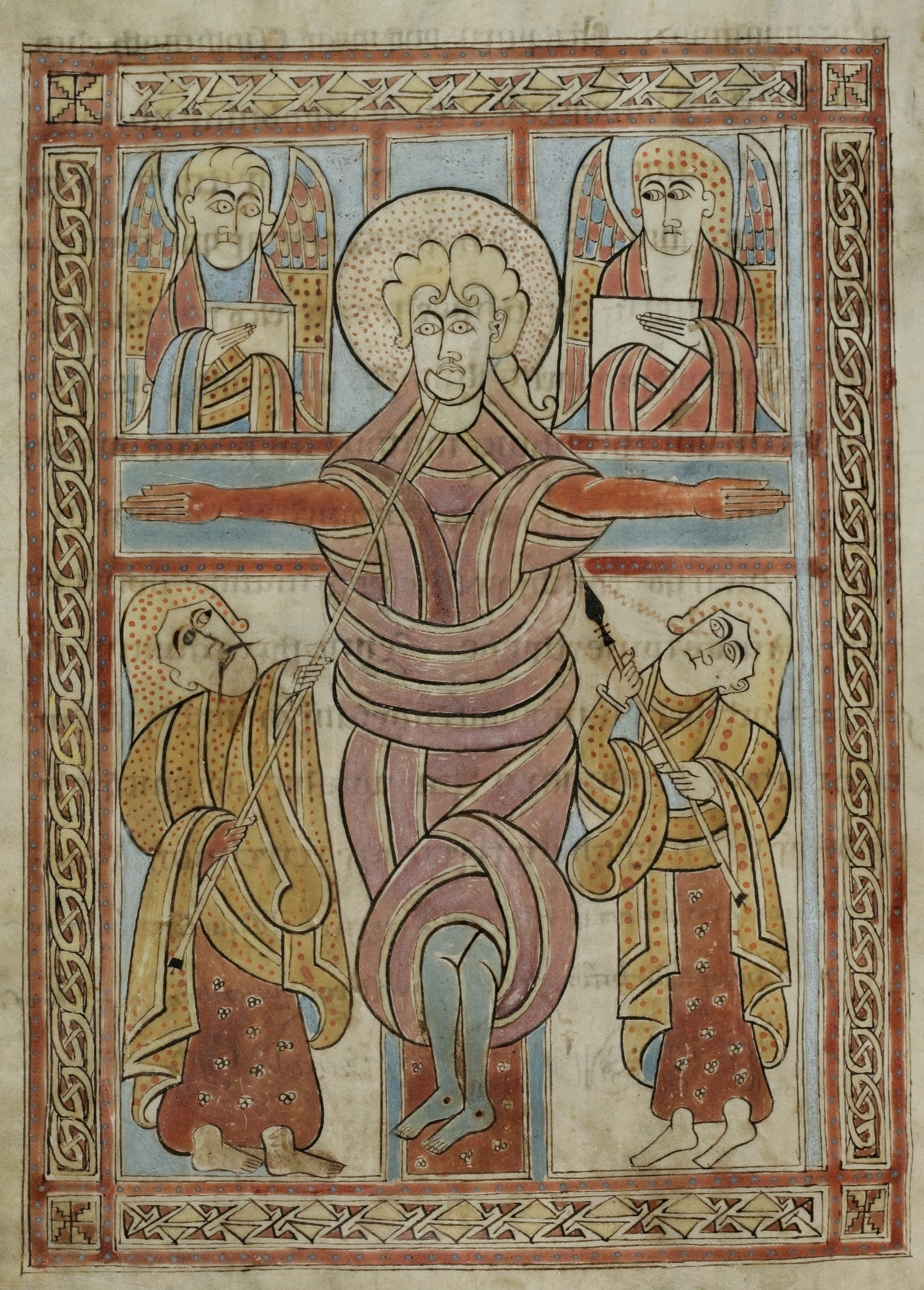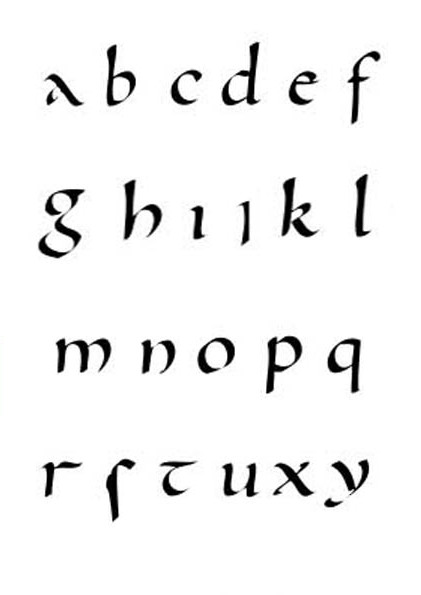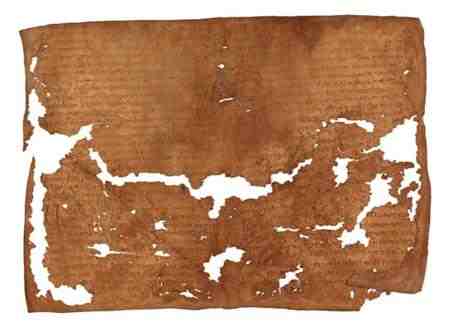|
Codex Sangallensis 51
The Irish Gospels of St. Gall or Codex Sangallensis 51 is an 8th-century Insular Gospel Book, written either in Ireland or by Irish monks in the Abbey of St. Gall in Switzerland, where it is now in the Abbey library of St. Gallen as MS 51. It has 134 folios (so 268 pages). Amongst its 11 illustrated pages are a Crucifixion, a Last Judgement, a Chi Rho monogram page, a carpet page, and Evangelist portraits. It is designated by 48 on the Beuron system, and is an 8th-century Latin manuscript of the New Testament. The text, written on vellum, is a version of the old Latin. The manuscript contains the text of the four Gospels on 134 parchment leaves (29 ½ × 22 ½ cm). It is written in two columns, in Irish semi-uncials. It has been in the St Gall library since at least the 10th century, when it is recorded in the earliest catalogue.Sanga ... [...More Info...] [...Related Items...] OR: [Wikipedia] [Google] [Baidu] |
Crucifixion Sankt Gallen Gospelbook
Crucifixion is a method of capital punishment in which the victim is tied or nailed to a large wooden cross or beam and left to hang until eventual death from exhaustion and asphyxiation. It was used as a punishment by the Persians, Carthaginians and Romans, among others. Crucifixion has been used in parts of the world as recently as the twentieth century. The crucifixion of Jesus of Nazareth is central to Christianity, and the cross (sometimes depicting Jesus nailed to it) is the main religious symbol for many Christian churches. Terminology Ancient Greek has two verbs for crucify: (), from (which in today's Greek only means "cross" but which in antiquity was used of any kind of wooden pole, pointed or blunt, bare or with attachments) and () "crucify on a plank", together with ( "impale"). In earlier pre-Roman Greek texts usually means "impale". The Greek used in the Christian New Testament uses four verbs, three of them based upon (), usually translated "cross". Th ... [...More Info...] [...Related Items...] OR: [Wikipedia] [Google] [Baidu] |
Uncial Script
Uncial is a majuscule Glaister, Geoffrey Ashall. (1996) ''Encyclopedia of the Book''. 2nd edn. New Castle, DE, and London: Oak Knoll Press & The British Library, p. 494. script (written entirely in capital letters) commonly used from the 4th to 8th centuries AD by Latin and Greek scribes. Uncial letters were used to write Greek and Latin, as well as Gothic and Coptic. Development Early uncial script most likely developed from late rustic capitals. Early forms are characterized by broad single-stroke letters using simple round forms taking advantage of the new parchment and vellum surfaces, as opposed to the angular, multiple-stroke letters, which are more suited for rougher surfaces, such as papyrus. In the oldest examples of uncial, such as the fragment of '' De bellis macedonicis'' in the British Library, of the late 1st-early 2nd century, all of the letters are disconnected from one another, and word separation is typically not used. Word separation, however, is characteri ... [...More Info...] [...Related Items...] OR: [Wikipedia] [Google] [Baidu] |
John The Evangelist
John the Evangelist ( grc-gre, Ἰωάννης, Iōánnēs; Aramaic: ܝܘܚܢܢ; Ge'ez: ዮሐንስ; ar, يوحنا الإنجيلي, la, Ioannes, he, יוחנן cop, ⲓⲱⲁⲛⲛⲏⲥ or ⲓⲱ̅ⲁ) is the name traditionally given to the author of the Gospel of John. Christians have traditionally identified him with John the Apostle, John of Patmos, and John the Presbyter, although this has been disputed by most modern scholars. Identity The Gospel of John refers to an otherwise unnamed "disciple whom Jesus loved", who "bore witness to and wrote" the Gospel's message.Theissen, Gerd and Annette Merz. The historical Jesus: a comprehensive guide. Fortress Press. 1998. translated from German (1996 edition). Chapter 2. Christian sources about Jesus. The author of the Gospel of John seemed interested in maintaining the internal anonymity of the author's identity, although interpreting the Gospel in the light of the Synoptic Gospels and considering that the author names ... [...More Info...] [...Related Items...] OR: [Wikipedia] [Google] [Baidu] |
Saint Mark
Mark the Evangelist ( la, Marcus; grc-gre, Μᾶρκος, Mârkos; arc, ܡܪܩܘܣ, translit=Marqōs; Ge'ez: ማርቆስ; ), also known as Saint Mark, is the person who is traditionally ascribed to be the author of the Gospel of Mark. According to Church tradition, Mark founded the episcopal see of Alexandria, which was one of the five most important sees of early Christianity. His feast day is celebrated on April 25, and his symbol is the winged lion. Mark's identity According to William Lane (1974), an "unbroken tradition" identifies Mark the Evangelist with John Mark, and John Mark as the cousin of Barnabas. However, Hippolytus of Rome in ''On the Seventy Apostles'' distinguishes Mark the Evangelist (2 Tim 4:11), John Mark (Acts 12:12, 25; 13:5, 13; 15:37), and Mark the cousin of Barnabas (Col 4:10; Phlm 1:24). According to Hippolytus, they all belonged to the "Seventy Disciples" who were sent out by Jesus to disseminate the gospel (Luke 10:1ff.) in Judea. According ... [...More Info...] [...Related Items...] OR: [Wikipedia] [Google] [Baidu] |
Carpet Page
A carpet page is a full page in an illuminated manuscript containing intricate, non-figurative, patterned designs.Moss, 57 They are a characteristic feature of Insular manuscripts, and typically placed at the beginning of a Gospel Book. Carpet pages are characterised by mainly geometrical ornamentation which may include repeated animal forms. They are distinct from pages devoted to highly decorated historiated initials, though the style of decoration may be very similar. Carpet pages are characterised by ornamentation with brilliant colors, active lines and complex patterns of interlace. They are normally symmetrical, or very nearly so, about both a horizontal and vertical axis, though for example the page at right is only symmetrical about a vertical axis. Some art historians find their origin in similar Coptic decorative book pages, and they also clearly borrow from contemporary metalwork decoration. Oriental carpets, or other textiles, may themselves have been influences. ... [...More Info...] [...Related Items...] OR: [Wikipedia] [Google] [Baidu] |
Last Judgment
The Last Judgment, Final Judgment, Day of Reckoning, Day of Judgment, Judgment Day, Doomsday, Day of Resurrection or The Day of the Lord (; ar, یوم القيامة, translit=Yawm al-Qiyāmah or ar, یوم الدین, translit=Yawm ad-Dīn, label=none) is part of the Abrahamic religions and the ''Frashokereti'' of Zoroastrianism. Christianity considers the Second Coming of Jesus Christ to entail the final judgment by God of all people who have ever lived, resulting in the approval of some and the penalizing of others. The concept is found in all the canonical gospels, particularly in the Gospel of Matthew. The Christian tradition is also followed by Islam, where it is mentioned in the 43rd chapter (''Az-Zukhruf'') of the Quran, according to some interpretations. Christian futurists believe it will follow the resurrection of the dead and the Second Coming of Jesus, while full preterists believe it has already occurred. The Last Judgment has inspired numerous artistic depic ... [...More Info...] [...Related Items...] OR: [Wikipedia] [Google] [Baidu] |
Crucifixion Of Jesus
The crucifixion and death of Jesus occurred in 1st-century Judea, most likely in AD 30 or AD 33. It is described in the four canonical gospels, referred to in the New Testament epistles, attested to by other ancient sources, and considered an established historical event. There is no consensus among historians on the details. Christopher M. Tuckett in ''The Cambridge companion to Jesus'' edited by Markus N. A. Bockmuehl 2001 Cambridge Univ Press pp. 123–124 In the canonical gospels, Jesus is arrested and tried by the Sanhedrin, and then by Pontius Pilate, who sentences him to flagellation and finally crucifixion by the Roman Empire.''The Cradle, the Cross, and the Crown: An Introduction to the New Testament'' by Andreas J. Köstenberger, L. Scott Kellum 2009 pp. 104–108Evans, Craig A. (2001). ''Jesus and His Contemporaries: Comparative Studies'' p. 316 Jesus was stripped of his clothing and offered vinegar mixed with myrrh or gall (likely posca ... [...More Info...] [...Related Items...] OR: [Wikipedia] [Google] [Baidu] |
Incipit
The incipit () of a text is the first few words of the text, employed as an identifying label. In a musical composition, an incipit is an initial sequence of notes, having the same purpose. The word ''incipit'' comes from Latin and means "it begins". Its counterpart taken from the ending of the text is the explicit. Before the development of titles, texts were often referred to by their incipits, as with for example ''Agnus Dei''. During the medieval period in Europe, incipits were often written in a different script or colour from the rest of the work of which they were a part, and "incipit pages" might be heavily decorated with illumination. Though the word ''incipit'' is Latin, the practice of the incipit predates classical antiquity by several millennia and can be found in various parts of the world. Although not always called by the name of ''incipit'' today, the practice of referring to texts by their initial words remains commonplace. Historical examples Sumerian In th ... [...More Info...] [...Related Items...] OR: [Wikipedia] [Google] [Baidu] |
Carolingian Minuscule
Carolingian minuscule or Caroline minuscule is a script which developed as a calligraphic standard in the medieval European period so that the Latin alphabet of Jerome's Vulgate Bible could be easily recognized by the literate class from one region to another. It is thought to have originated before AD 778 at the scriptorium of the Benedictine monks of Corbie Abbey, about north of Paris, and then developed by Alcuin of York for wide use in the Carolingian Renaissance. Alcuin himself still wrote in a script which was a precursor the Carolingian minuscule, which slowly developed over three centuries. He was most likely responsible for copying and preserving the manuscripts and upkeep of the script. It was used in the Holy Roman Empire between approximately 800 and 1200. Codices, pagan and Christian texts, and educational material were written in Carolingian minuscule. After blackletter developed out of it, the Carolingian minuscule became obsolete, until the 14th century Ital ... [...More Info...] [...Related Items...] OR: [Wikipedia] [Google] [Baidu] |
Faddan More Psalter
The Faddan More Psalter ( ga, Saltair an Fheadáin Mhóir) (also Irish Bog Psalter or "Faddan Mor Psalter") is an early medieval Christian psalter or text of the book of Psalms, discovered in a peat bog in July 2006, in the townland of Faddan More ( ga, Feadán Mór) in north County Tipperary, Ireland. The manuscript was probably written in about 800 CE in one of a number of monasteries in the area. After several years of conservation work, the psalter went on display at the National Museum of Ireland – Archaeology in Kildare Street, Dublin in June 2011.NMI This discovery was hailed by the National Museum of Ireland as one of the most significant Irish archaeological finds in decades.Ancient manuscript discovered in the Midlands – RTÉ News, 25 July 2006 Bernard Meehan of the |
Minuscule
Letter case is the distinction between the letters that are in larger uppercase or capitals (or more formally ''majuscule'') and smaller lowercase (or more formally ''minuscule'') in the written representation of certain languages. The writing systems that distinguish between the upper and lowercase have two parallel sets of letters, with each letter in one set usually having an equivalent in the other set. The two case variants are alternative representations of the same letter: they have the same name and pronunciation and are treated identically when sorting in alphabetical order. Letter case is generally applied in a mixed-case fashion, with both upper and lowercase letters appearing in a given piece of text for legibility. The choice of case is often prescribed by the grammar of a language or by the conventions of a particular discipline. In orthography, the uppercase is primarily reserved for special purposes, such as the first letter of a sentence or of a proper noun (ca ... [...More Info...] [...Related Items...] OR: [Wikipedia] [Google] [Baidu] |



.jpg)


.jpg)

